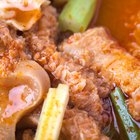trebuchet/iStock/GettyImages
If tripe were a traditional cut of beef instead of a variety meat, honeycomb tripe would be prime rib, and the other types – blanket and book – would be sirloin. Named for their textures, blanket tripe feels like a fuzzy blanket; book tripe has overlapping, page-like layers; and honeycomb tripe – the most tender and flavorful of the three – has a honeycomb-like texture that acts like a flavor sponge during cooking. To make the most of honeycomb tripe, follow the three "Ss" of offal: simmer for palatability, stew for flavor and saute for texture.
Simmering for Palatability
Rinse the tripe under cold running water until it runs clear. Run your fingers over both sides of the tripe, especially in the crevices in the honeycomb side, until it feels sleek and squeaky clean.
Cover the tripe with about 3 or 4 inches of cold water mixed with a heavy pour of white distilled vinegar in a heavy-bottomed pot. Boil the tripe for 2 or 3 minutes and lower the heat to a simmer.
Simmer the tripe until you can tear it easily, about 2 hours. Turn off the heat and let the tripe reach room temperature with the water. If you have an electric stove, take the pot off the burner.
Strain the tripe and reserve a few cups of the cooking liquid. Slice the tripe in 1/4-inch-wide strips.
Stewing for Flavor
Saute aromatic ingredients until golden and fragrant in a few tablespoons of oil, butter or rendered fat in a Dutch oven or deep, heavy-bottomed pan. You're building base flavors at this point, so choose a pungent, balanced selection of aromatics, such as garlic, shallots or onions and celery root.
Add a spoonful or 2 of tomato paste and cook until darkened, stirring frequently with a wooden spoon, to make a pincage. A pincage comprises aromatics and caramelized tomato paste, and builds a strong flavor that ties everything together.
Add a can or 2 of peeled stew tomatoes and crush them with the wooden spoon. Canned tomatoes have more acid than fresh, so they break down the tripe faster.
Add the tripe along with the reserved cooking liquid. Add freshly chopped herbs, kosher salt and freshly ground black pepper to the tripe and stir.
Cover the pan and adjust the heat so the cooking liquid barely simmers. Braise the tripe until it's infused with flavor and you can cut it with a fork, about 1 hour.
Serve the braised tripe with the sauce, or reserve the sauce and remove the tripe if you want to fry it for texture.
Sauteing for Texture
Rinse the tripe with cool running water to cool it down and remove the tomato sauce. Don't worry; the tripe is already infused with flavor, and you'll return it to the sauce later. You have to remove the tomato sauce so it doesn't scorch during frying.
Heat a few tablespoons of oil in a saute pan. Pat the tripe dry with paper towels.
Dredge the tripe in all-purpose flour and add it to the pan. Saute the tripe until golden brown and crisp, about 2 or 3 minutes, stirring frequently.
Drain the tripe on paper towels and stir it into the sauce. Add fresh herbs to taste.
Heat the tripe and sauce and serve it as-is or over pasta, rice or another starch.
Related Articles

How to Cook Tripe

How to Cook With Pinot Grigio
How to Cook a Lamb Square Cut Shoulder

How to Cook Manioc Root

How to Cook Beef Intestines

Can Chuck Roast Be Used for Stew?

How to Cook Veal Sirloin

How to Slow Cook Brisket With Brown ...

How to Cook a Bone-in Leg of Lamb

How Do I Cook Pork Spine?

How to Cook Tripe Italian-Style

How to Cook an Elk Shoulder
How to Cook a Seven Bone Pot Roast in ...

How to Cook Moose Meat

How to Cook a Sirloin Like a Prime Rib

Slow Roasting a Leg of Lamb Until It Is ...

How to Cook Brisket Braised Strips

How to Cook Fresh Pork Tongue

How to Make Soup Out of Pulp From ...

Ideas for Cooking Boston Butt Strips
References
Writer Bio
A.J. Andrews' work has appeared in Food and Wine, Fricote and "BBC Good Food." He lives in Europe where he bakes with wild yeast, milks goats for cheese and prepares for the Court of Master Sommeliers level II exam. Andrews received formal training at Le Cordon Bleu.